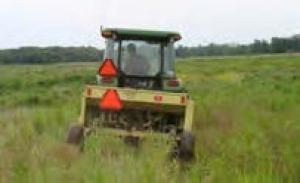Planting Considerations Toolbox Home
Considerations prior to planting involve deciding if seeds or containerized plants will be used, or a combination of seeds and plants, as well as how the planting will be designed. Seed is typically used for large plantings, while containerized plants are a better option for smaller urban projects.
When planting containerized plants grouping species together is beneficial for pollinators as it makes it easier for them to find flowers and more efficient for them to collect pollen and nectar. If pesticide application in adjoining landscapes poses a threat to pollinator plantings strategies should be considered to protect plantings. A new fact sheet has been developed by BWSR and Xerces Society on strategies to protect pollinator plantings from pesticides.
Timing
Seeding - The timing of planting pollinator habitat will vary depending on whether containerized plants will be installed or seed. Seeding of pollinators seed mixes is often conducted in the fall to allow forb seeds to naturally break dormancy over winter and grow quickly in the spring. This allows them to compete with grasses that are often more dominant in conservation plantings. Most forbs need a winter to break dormancy but there are some forbs that are important for pollinators (Sneezeweed, Dutchman's Breeches, Bugleweed, Wild Bergamot, Evening Primrose, Smooth Blue Aster, Mountain Mint, and Asters) that do not require pre-stratification, so these species can be successfully seeded in the spring or fall.
Containerized Plants - Spring is the most common time to plant containerized plants for pollinators as there is often better soil moisture during that time of year. Late fall has also been successful for planting containerized plants but it is important that plants are watered before winter to prevent roots from drying out.
Methods
Seeding -As was noted in the discussion about "Preparing for Planting" it is important that weeds are thoroughly controlled before planting and that the seedbed is prepared. Pollinator seed is most often broadcast onto the soil surface as most forb seeds are very tiny and light in order to germinate. Grasses benefit from being planted deeper but their seeds can often be drill seeded, harrowed, or raked into the soil first, followed by broadcasting the flower seeds on the surface. It can be helpful to use a garden roller as a final step after seeding to ensure that the seed has good contact with the soil to aid establishment. In some cases seed and containerized plants are combined for larger plantings as some forb species do not establish well from seed or grow slowly, such as gentian, liatris, butterfly milkweed, Turk's Cap Lily and many woodland flowers. If forbs will be added they should be planted after seeding and sufficiently watered after planting to ensure their survival.
Containerized plants also work better for small urban projects as weeds can be controlled through weed suppression paper products and wood mulch (see more information on BWSR's "What's Working for Conservation - Pollinator Habitat" webpage. Installing containerized plants also allows for grouping similar plants together to create a sense of order in a plantings. Containerized plants are typically planted one to two feet apart with one and a half feet being a common spacing. Containerized plants are commonly installed as plugs which are relatively small (about 1- 1.5 inch wide) containers but 2-inch, 1-inch and gallon containers are also available and can increase the rate of establishment for projects.
Inter-seeding - Seeding additional forbs into projects is sometimes conducted to increase diversity in existing conservation plantings. Burning, tilling, or other types of site preparation are often necessary before inter-seeding to suppress existing vegetation and mowing to around 5-8 inches is typically necessary afterward to aid seedling establishment. See the summary of inter-seeding methods on the Vegetation Establishment and Management webpage.

